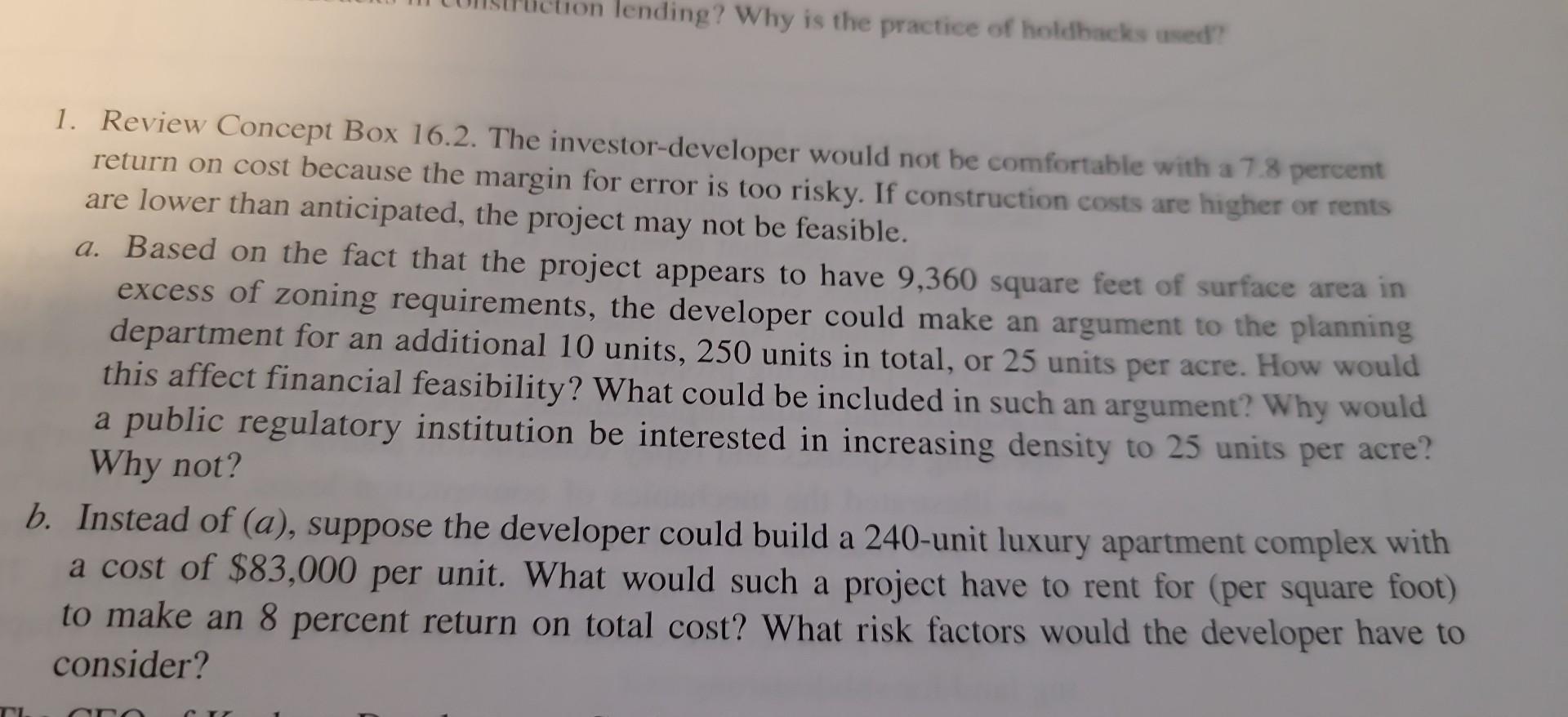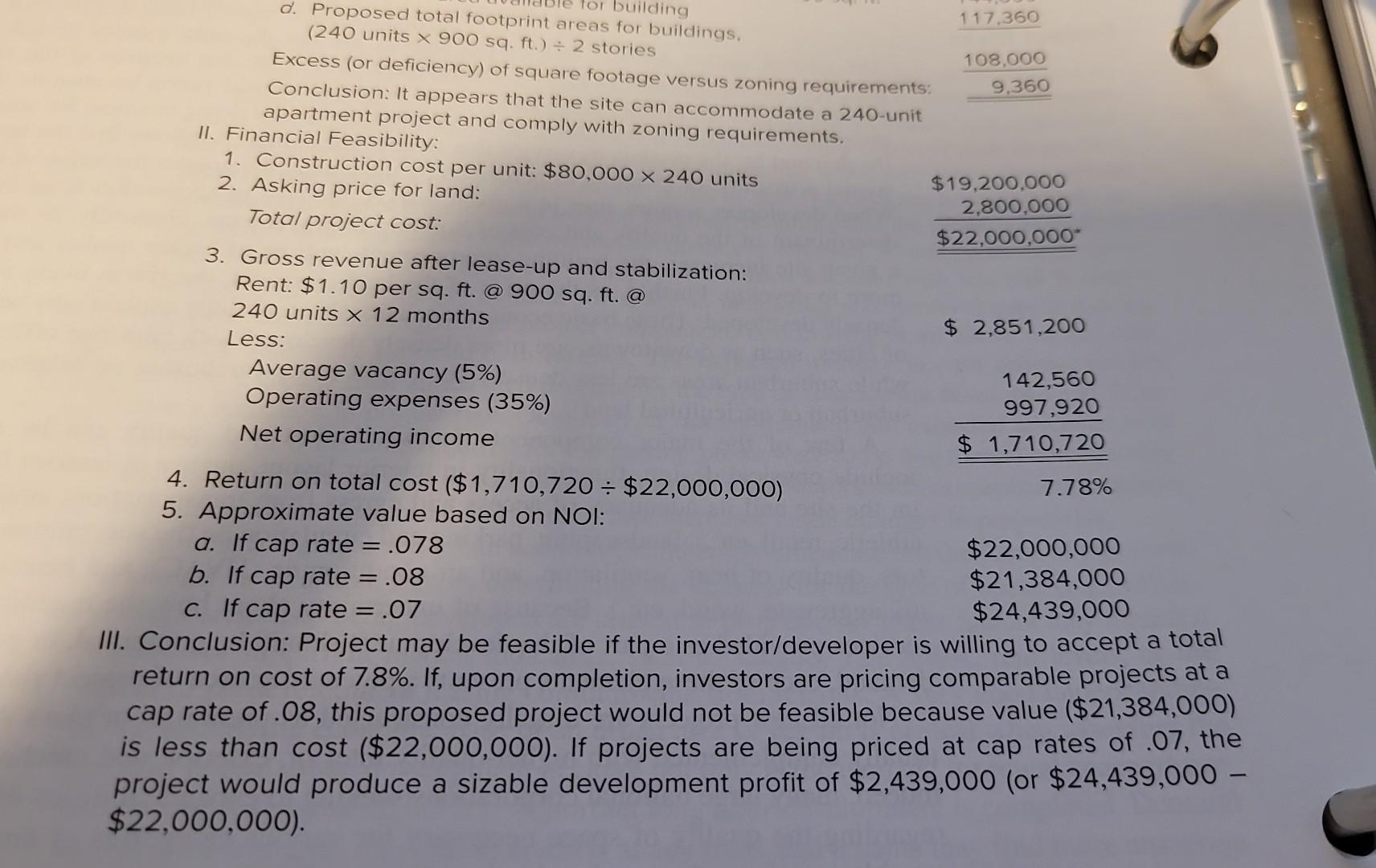Answered step by step
Verified Expert Solution
Question
1 Approved Answer
That is all of the information 1. Review Concept Box 16.2. The investor-developer would not be comfortable with a 7.8 percent return on cost because



That is all of the information
1. Review Concept Box 16.2. The investor-developer would not be comfortable with a 7.8 percent return on cost because the margin for error is too risky. If construction costs are higher or rents are lower than anticipated, the project may not be feasible. a. Based on the fact that the project appears to have 9,360 square feet of surface area in excess of zoning requirements, the developer could make an argument to the planning department for an additional 10 units, 250 units in total, or 25 units per acre. How would this affect financial feasibility? What could be included in such an argument? Why would a public regulatory institution be interested in increasing density to 25 units per acre? Why not? b. Instead of (a), suppose the developer could build a 240-unit luxury apartment complex with a cost of $83,000 per unit. What would such a project have to rent for (per square foot) to make an 8 percent return on total cost? What risk factors would the developer have to consider? 1. Physical Feasibility: 1. Goal: To provide a preliminary development plan analysis to determine whether an apartment project can be built on a specific site in accordance with regulatory requirements and leased at current rental rates in order to justify land acquisition. 2. Site: 10 acres or 435,600 sq. ft. 3. Asking price: $2,800,000 4. Basic project description/zoning: a. Setback requirements: 15% b. Circulation requirements: 15% c. Maximum units per acre: 24 (based on a unit mix of 1-, 2-, and 3-bedroom apartments; weighted average =900 sq. ft. per unit) d. Parking requirements: 1.5 spaces per unit @ 400 square feet per space e. Open space, berms, landscape, support area: 1.0 acre (required) based on 240 units f. Maximum building height: 2 stories apartment project and comply with zoning requirements. Financial Feasibilitv: III. Conclusion: Project may be feasible if the investor/developer is willing to accept a total return on cost of 7.8%. If, upon completion, investors are pricing comparable projects at a cap rate of .08 , this proposed project would not be feasible because value ($21,384,000) is less than cost ($22,000,000). If projects are being priced at cap rates of .07 , the project would produce a sizable development profit of $2,439,000 (or $24,439,000 $22,000,000) 1. Review Concept Box 16.2. The investor-developer would not be comfortable with a 7.8 percent return on cost because the margin for error is too risky. If construction costs are higher or rents are lower than anticipated, the project may not be feasible. a. Based on the fact that the project appears to have 9,360 square feet of surface area in excess of zoning requirements, the developer could make an argument to the planning department for an additional 10 units, 250 units in total, or 25 units per acre. How would this affect financial feasibility? What could be included in such an argument? Why would a public regulatory institution be interested in increasing density to 25 units per acre? Why not? b. Instead of (a), suppose the developer could build a 240-unit luxury apartment complex with a cost of $83,000 per unit. What would such a project have to rent for (per square foot) to make an 8 percent return on total cost? What risk factors would the developer have to consider? 1. Physical Feasibility: 1. Goal: To provide a preliminary development plan analysis to determine whether an apartment project can be built on a specific site in accordance with regulatory requirements and leased at current rental rates in order to justify land acquisition. 2. Site: 10 acres or 435,600 sq. ft. 3. Asking price: $2,800,000 4. Basic project description/zoning: a. Setback requirements: 15% b. Circulation requirements: 15% c. Maximum units per acre: 24 (based on a unit mix of 1-, 2-, and 3-bedroom apartments; weighted average =900 sq. ft. per unit) d. Parking requirements: 1.5 spaces per unit @ 400 square feet per space e. Open space, berms, landscape, support area: 1.0 acre (required) based on 240 units f. Maximum building height: 2 stories apartment project and comply with zoning requirements. Financial Feasibilitv: III. Conclusion: Project may be feasible if the investor/developer is willing to accept a total return on cost of 7.8%. If, upon completion, investors are pricing comparable projects at a cap rate of .08 , this proposed project would not be feasible because value ($21,384,000) is less than cost ($22,000,000). If projects are being priced at cap rates of .07 , the project would produce a sizable development profit of $2,439,000 (or $24,439,000 $22,000,000)Step by Step Solution
There are 3 Steps involved in it
Step: 1

Get Instant Access to Expert-Tailored Solutions
See step-by-step solutions with expert insights and AI powered tools for academic success
Step: 2

Step: 3

Ace Your Homework with AI
Get the answers you need in no time with our AI-driven, step-by-step assistance
Get Started


